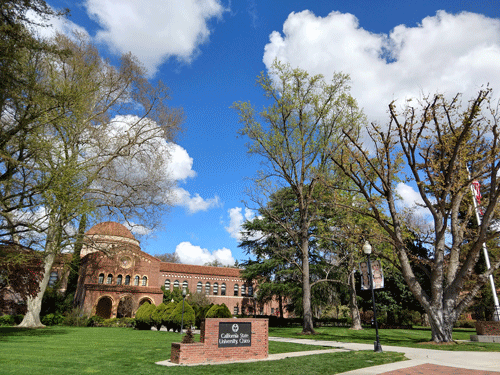Welcome to the GEOS 170, Environment II: Weather, webpage for the Spring 2019 semester.

Spring 2019 Lectures: MWF, 12:00 - 12:50 PM. Location: PAC 206
Click here for a PDF of the Syllabus.
Required book: Meteorology Today 12th edition by C. Donald Ahrens and Robert Henson.
This page will be updated every few days as the course progresses.
Weds., 23 Jan., Review syllabus and discussion of AMS, AGU, and billion dollar disasters.
Fri., 25 Jan., Discussion of national weather, billion dollar disasters, CA wildfires, and Begin chapter 1.
Mon., 28 Jan., Continue with Chapter 1: Earth and its atmosphere.
Weds., 30 Jan., Weather technologies and observations.
Fri., 1 Feb., Begin Chapter 2: Energy and warming and cooling of the atmosphere. Homework #1 on Chapter 1 due.
Mon., 4 Feb., Quiz on Chapter 1. Continue with Chapter 2: Flux, phase change, latent heats, conduction.
Weds., 6 Feb., Continue with Chapter 2: energy transfer in the atmosphere.
Fri., 8 Feb., Class cancelled. Special assignment #1 on energy transfer.
Mon., 11 Feb., Quiz on Chapter 2. Then begin radiant energy and selective absorbers. Pages 39-44.
Weds., 13 Feb., Complete Chapter 2 (Earth's energy budget and greenhouse effect, pages 44-51) and begin Chapter 3.
Fri., 15 Feb., What causes the seasons? Then, warming and cooling of the air near the surface.
Mon., 18 Feb., Quiz on Chapter 3. Then complete Chapter 3: Why air at night often flows downslope. Then Begin Chapter 4: Atmospheric humidity.
Weds., 20 Feb., Instruments to measure humidity, use of psychrometric charts, dew point and weather maps, water vapor feedback
Fri., 22 Feb., Quiz on Chapter 4. Then, completed Chapter 4 and began Chapter 5 on Condensation: Dew, Fog, and Clouds. Condensation nuclei.
Mon., 25 Feb., Haze, visibility, fog. Radiation fog and advection fog.
Weds., 27 Feb., Exam #1 on Chapters 1 - 4.
Fri., 1 Mar., Review exam results. Then upslope and mixing fogs, and cloud types.
Mon., 4 Mar., Quiz #5. Then, combustion of gasoline, carbon dioxide, efficiency, electric cars, and more on special cloud types.
Weds., 6 Mar., Instructor ill. No class.
Fri., 8 Mar., Complete Chapter 5 and begin Chapter 6 on Stability and Cloud Development. Lapse rates.
Mon., 11 Mar., Quiz #5b. Then continue with stability: absolute stability.
Weds., 13 Mar., Quiz #5c. Then, absolute instability, conditional instability, neutrality, and lifting mechanisms.
Fri., 15 Mar., Class cancelled. Special assignment #2 on lapse rates and stability.
Mon., 18 Mar., Spring break. No classes.
Weds., 20 Mar., Spring break. No classes.
Fri., 22 Mar., Spring break. No classes.
Mon., 25 Mar., Clouds, controls on vertical development of cumulus, cloud streets, wave clouds, Kelvin-Helmholtz billows.
Weds., 27 Mar., Quiz #6 on Chapter 6.Then begin Chapter 7: Precipitation. The curvature and solute effects for droplet growth.
Fri., 29 Mar., Continue with precipitation processes: Collision and coalescence process and the ice-crystal or Bergeron process.
Mon., 1 Apr., Cesar Chavez Day: No classes.
Weds., 3 Apr., Discussion of yesterday's weather: thunderstorms and tornadoes. Then precipitation processes and types of precipitation.
Fri., 5 Apr., Quiz #7. Then, begin Chapter 8: Air pressure and winds. Pressure, barometers, correction for altitude, isobars.
Mon., 8 Apr., Constant pressure surfaces, isoheights (isohypses), scalars, vectors, pressure gradients, pressure gradient forces.
Weds., 10 Apr., Hydrostatic and geostrophic balance.
Fri., 12 Apr., Quiz #8. The effects of turbulence: "Friction". Convergence and divergence, rising and sinking air in highs and lows. Start Chapter 9.
Mon., 15 Apr., SETs. Then review Chapters 5 - 8 for Exam #2.
Weds., 17 Apr., Exam #2 on Chapters 5 - 8.
Fri., 19 Apr.,Continue Chapter 9: ways of generating turbulence: mechanical and thermal. Molecular and eddy viscosity. Boundary Layers.
Mon., 22 Apr., Aeolian processes. Then thermal circulations: sea-breeze, land-breeze, valley breeze, mountain breeze.
Weds., 24 Apr., Complete Chapter 9: katabatic flows, Antarctica, The Dust Bowl, Chinooks, Haboobs, and wind measurement technology.
Fri., 26 Apr., Quiz #9 on Chapter 9. Begin Chapter 10: Wind: Global Systems: 3-cell model, ITCZ, Hadley cells, semi-permanent highs and lows.
Mon., 29 Apr., Continue Chapter 10. Discussion of zonal vs meridional, knots vs MPH, jet streams. Then, begin air-sea interaction and waves.
Weds., 1 May, Ocean surface layer dynamics: Ekman spiral & transport, upwelling, downwelling; El Niño, La Niña, ENSO.
Fri., 3 May, Quiz #10 on Chapter 10. Teleconnections, Pacific decadal oscillation; North Atlantic and Arctic oscillations.
Mon., 6 May, Begin comprehensive review: composition of the atmosphere; pressure, temperature, density. Conduction and convection.
Weds., 8 May, Continue comprehensive review: heat capacity vs latent heat; sensible versus latent heat, radiation, global energy budget.
Fri., 10 May, Conclude comprehensive review.
Weds., 15 May, 12:00 - 1:50 PM, Comprehensive final exam.
Dr. Mayor's page
